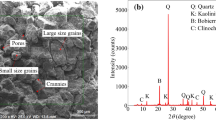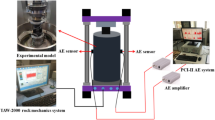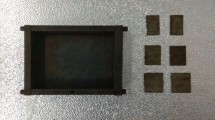Abstract
Natural fractures are widely distributed in rocks. Generally, there are four types of natural fractures, i.e., single, parallel, intersected and mixed. Uniaxial compression tests on naturally fractured marble samples, taken from the transportation tunnels of Jinpin II hydropower station in southwestern China, are conducted with a MTS815 rock mechanics testing system. The acoustic emission (AE) events are monitored by PCI-II AE system. The spatial evolutions of different natural fractures have been successfully located and tracked according to the AE ringing number. Experimental results indicate that the failure process of fractured marble is locally progressive. The AE event accumulation is strongly related to the loading process and stress redistribution in rock. For the former two types, i.e., single and parallel natural fractures, the spatial AE event distributions in marbles are relatively simpler than those of the other two. The corresponding strong AE event numbers (with ringing number greater than 20) increase with the compressive stress along the naturally fractured surfaces when the stress is low. When the compressive stress is close to the failure strength of the rock, AE events first appear around the natural fracture tip, then spread along the final rupture direction. For the marble containing intersected natural fractures, strong AE events are approximately uniformly distributed at the initial stage of the compression test. Later, the AE events increase when the compressive stress gets higher continuously, and then concentrate around the intersection points of fractures. The case with mixed natural fractures has the most complex AE event distribution than those of the others. However, it is still not difficult to determine the internal weakness parts and stress field based on the spatial AE event distribution. The fractal dimension of the spatial AE event distribution, capable of describing the mechanical behavior and structural damage of rock materials, is estimated by a newly developed analysis method. The parameters of AE events for different types of natural fractures, such as AE accumulative value, amplitude and absolute energy, are statistically analyzed. The present testing scheme can be an initial step toward further development of in situ microseismic monitoring techniques for complex fractures. Moreover, the obtained experimental and analytical results can facilitate the investigation on rock mass failure and instability mechanism.
















Similar content being viewed by others
References
Georg D, Sergei S, Erik R (2010) Borehole breakout evolution through acoustic emission location analysis. Int J Rock Mech Min Sci 47:426–435
Haeri H, Shahriar K, Marji MF, Moarefvand P (2013) On the crack propagation analysis of rock like Brazilian disc specimens containing cracks under compressive line loading. La Am J Solids Struct 11(8):1400–1416
Hardy HR Jr (1972) Application of acoustic emission techniques to rock mechanics research. Acoust Emiss ASTM STP 505:41–83
Heping X, Jianliang P et al (2011) Investigation of mechanical properties of fractured marbles by uniaxial compression tests. J Rock Mech Geotech Eng 3(4):302–313
Hirata T, Satoh T, Ito K (1987) Fractal structure of spatial distribution of microfracturing in rock. Geophs J R Astr Soc 90(2):369–374
Jansen DP, Carlson SR, Young RP et al (1999) Ultrasonic imaging and acoustic emission monitoring of thermally induced microcracks in Lac du Bonnet Granite. J Geophys Res B 8(12):22231–22243
Jiang H, Ma S, Zhang L et al (2003) AE spatial-temporal evolution distribution during the deformation of rock sample contained a collinear fault with and unconnected area. Earthquake 23(3):1–9 (in Chinese)
Katsuyama K (1997) Applications of acoustic emission (AE) techniques [M]. Translated by Feng Xiating. China Metallurgical Industry Press, Beijing (in Chinese)
Kranz RL (1983) Microcracks in rocks: a review. Tectonophysics 100(1):449–480
Lei XL, Masuda K, Nishizawa O et al (2004) Detailed analysis of acoustic emission activity during catastrophic fracture of faults in rock. J Struct Geol 26:247–258
Li YH, Liu JP, Zhao XD, Yang YJ (2010) Experimental studies of the change of spatial correction length of acoustic emission events during rock fracture process. Int J Rock Mech Min Sci 47:1254–1262
Liu Quansheng, Jie Xu, Liu Xuewei et al (2015) The role of flaws on crack growth in rock-like material assessed by AE technique. Int J Fract 193:99–115
Lockner D (1993) The role of acoustic emission in the study of rock fracture. Int J Rock Mech Min Sci Geomech Abstr 30(7):883–899
Mogi K (1968) Source location of elastic shocks in the fracturing process in rock. Bull Earthq Res Inst Tokyo Univ 46:1103–1125
Nanjo Kazuyoshi, Nagahama Hiroyuki (2004) Fractal properties of spatial distributions of aftershocks and active faults. Chaos Solitons Fractals 19(2):387–397
Pei J, Liu J, Ru Z et al (2010) Fractal study on spatial distribution of acoustic emission events of granite specimens under uniaxial compression[J]. J SiChuan Univ (Eng Sci Edition) 42(6):51–55 (in Chinese)
Scholz CH (1968) Experimental study of the fracturing process in Brittle Rock. J Geophys Res 74(4):1447–1454
Sobolev G, Getting IC, Spetzler H (1987) Laboratory study of the strain field and acoustic emissions during failure of barrier. J Geophys Res 92(B9s):9311–9318
Vidya Sagar R, Raghu Prasad BK (2013) Laboratory investigations on cracking in reinforced concrete beams using on-line acoustic emission monitoring technique. J Civil Struct Health Monit 3:169–186
Wang CL, Wu AX, Liu XH et al (2009) Study on fractal characteristics of b value with microseismic activity in deep mining. Procedia Earth Planet Sci 1(1):592–597
Xie H (1996) Introduction to fractal rock mechanics. Science Press, Beijing (in Chinese)
Xie HP, Liu JF et al (2011) Fractal property of spatial distribution of acoustic emissions during the failure process of bedded rock salt. Int J Rock Mech Min Sci 48:1344–1351
Yuan RF, Li H (2009) Fractal analysis on the spatial distribution of acoustic emission in the failure process of rock specimens. Int J Miner Metall Mater 16(1):19–24
Z X, Li Y, Yuan R et al (2007) Study on crack dynamic propagation process of rock samples based on acoustic emission location. Chin J Rock Mech Eng 26(5):944–950 (in Chinese)
Zhao X, Li Y, Liu J et al (2008a) Study on rock failure process based on acoustic emission and its location technique. Chin J Rock Mech Eng 27(5):990–995 (in Chinese)
Zhao X, Chen C, Liu J et al (2008b) Experimental study on AE activity characteristics of different rock samples. J Northeast Univ (Nat Sci) 29(11):1633–1636 (in Chinese)
Zhou XP, Cheng H, Feng YF (2014) An experimental study of crack coalescence behavior in rock-like materials containing multiple flaws under uniaxial compression. Rock Mech Rock Eng 47(6):1961–1986
Acknowledgments
The work is supported by the China National Natural Science Fund (CSNF) under Nos. 51120145001, 51374148, 51379139 and 51409179. The authors wish to offer their gratitude and regards to everyone who has been a part and support to this project in all means.
Author information
Authors and Affiliations
Corresponding author
Rights and permissions
About this article
Cite this article
Pei, J., Fei, W. & Liu, J. Spatial evolution and fractal characteristics of natural fractures in marbles under uniaxial compression loading based on the source location technology of acoustic emission. Environ Earth Sci 75, 828 (2016). https://doi.org/10.1007/s12665-016-5649-7
Received:
Accepted:
Published:
DOI: https://doi.org/10.1007/s12665-016-5649-7




